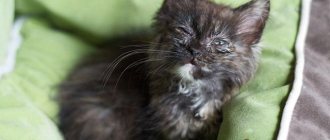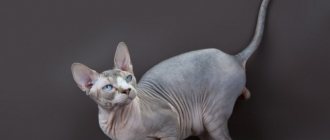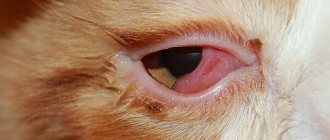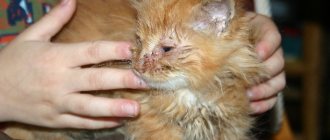Tearing in cats is normal as long as the fluid is clean and clear. But sometimes even a healthy kitten’s eyes begin to fester. The reasons may be structural features of the muzzle, improper diet, a reaction to household chemicals used by the owner, or the development of a serious pathology in the animal’s body. Let's find out how to properly wash a cat's eyes at home, and in what cases the help of a veterinarian is needed.
Why do my kitten's eyes fester?
Suppuration in the eye area in kittens under 3 months of age is a fairly common problem. Moreover, this is not always associated with the influence of the external environment; most often, kittens are born with a problem that gets worse as the animal grows.
Why do a kitten's eyes fester?
- Chlamydia . Oddly enough, not only people, but also cats suffer from this disease. The disease is usually transmitted to kittens when passing through the mother's birth canal. A cat gives birth to her babies with chlamydia, which is why they have infectious conjunctivitis.
- Follicular conjunctivitis . Occurs when inflammation of the lymph nodes occurs. Along with discharge from the eyes, photophobia and swelling in the eyelid area will be observed. Please note that with this disease, hair around the eyes very often falls out.
- Purulent conjunctivitis . Most often it manifests itself in both eyes; with this disease, the cat experiences not only purulent discharge, but also an elevated temperature. Initially, the discharge from the eye area is very thin, but gradually becomes thick, with a green or yellow tint.
Purulent eye
Symptoms
It is easy to recognize the first symptoms of conjunctivitis in a pet. At first, the kitten's eyes become red and watery. Then the eyelids swell, discharge appears, which forms crusts on the fur. The pet looks depressed and unkempt. In bright light he squints because he feels discomfort.
Redness of the eyelids and discharge of pus
If there is heavy discharge, the kitten’s eyes will not open after sleep, as the pus sticks together the hairs of the fur on the eyelids. The discharge comes in different colors - greenish, yellow, white or brown.
Sometimes eye inflammation is accompanied by general malaise and other alarming symptoms. For example:
- If the eyes fester and the kitten sneezes, the cause of this condition may be chlamydia or toxoplasmosis. In these diseases, the infection affects several body systems at once, except the eyes - the respiratory organs, the digestive tract.
- Purulent eyes, cough with runny nose occurs with mycoplasmosis. The disease develops most often in kittens that are not yet 1 month old. If treatment is not started on time, the infection will affect the liver, genitourinary system, and joints.
- Soreness and swelling of the eyelids in one eye indicates a blockage of the tear duct. This pathology usually occurs in kittens under three weeks of age.
- Purulent discharge from under the eyelids mixed with blood is a sign of injury.
The kitten is a month old, its eyes are festering: reasons
With blepharitis, the eyelids become inflamed. This occurs due to exposure to an allergen, burn, or contact with harmful chemicals. Blepharitis occurs when a kitten is infected with worms, or with seborrhea. Often occurs due to vitamin deficiency.
Kitten is one month old, eyes are festering, reasons:
- Lesion in the eyelid area . This happens if the baby has a conflict with his brothers and sisters, or other animals with whom he lives. Perhaps you didn’t notice when the cats got into a fight and one scratched the other’s eye.
- Foreign object in the eyelid area . Just like in humans, when particles or food particles come into contact, the eyelids become swollen and the eyes turn sour. It is necessary to remove the foreign object from the eye.
- Violation of temperature standards in the room . In a draft, the kitten may catch a cold.
- Viral diseases. This often happens to homeless and domestic cats. A doctor will help you deal with such ailments.
Conjunctivitis
Suppuration: normal or pathological?
Eye discharge does not always appear due to pathological processes developing in the body.
In some cases, pus in a cat accumulates under the eyelids for the following reasons:
- weakened immune system;
- improperly selected diet (lack of nutrients);
- infectious, viral damage;
- unsanitary conditions when keeping animals;
- draft;
- eye injuries;
- allergic reaction to household chemicals, perfumes;
- inflammatory processes in the cornea (keratitis);
- dust in the room where the pet is kept.
On a note! If the discharge is abundant and prolonged, you should not resort to self-medication; the animal must be taken for examination to a veterinary clinic, where the doctor will determine the cause and prescribe adequate treatment.
The owner should pay attention to the color of the discharge. Rare discharge of a grayish tint is normal, and thick discharge of a yellowish or green tint most likely indicates the development of pathological processes in the body.
The kitten has snot and festering eyes - reasons: how to treat?
Calcivirus (calcivirosis) is a dangerous viral disease that affects approximately 30% of cats. It is not necessary that the cat be an outdoor cat. The virus can often be carried on clothing or on unwashed hands. The virus can survive on clothes and shoes for about one to two weeks without being introduced into the animal’s body. Therefore, the owner can bring illness from the street. Calcivirus is not dangerous for people, but about a third of cats die from this viral disease and the complications it causes.
Calcivirosis is manifested by the following symptoms:
- Runny nose and sneezing for one to two days.
- Heavy discharge from the eyes. They appear around the third day. The cat's appetite worsens, it may refuse to eat, and its body temperature rises.
- Around the seventh day, small ulcers and stomatitis may appear in the mouth.
The kitten has snot and festering eyes, how to treat:
- Treatment of calcivirosis is antiviral. The animal is given immunomodulators, and concomitant infections that are caused by weakening of the body as a result of exposure to the virus are also treated.
- Very often, cats die from bacterial complications that arise from the virus. Among them are pneumonia, arthritis, arthrosis, dehydration, and kidney failure. These ailments are caused by a virus and its untimely treatment.
- Rashes in the mouth are treated with antiseptics, lubricated with Lugol, and washed with furatsilin solution. Cats are vaccinated against such diseases at a young age. If the cat is outdoors, then the virus can enter the body, because it is transmitted from mother to child.
Conjunctivitis
Treatment of eye inflammation in cats
In many mild cases of eye inflammation that does not have an infectious cause, the condition may go away on its own. However, it is unwise to delay veterinary treatment based on this fact, since conjunctivitis may be a symptom of another, more serious condition.
© shutterstock
The treatment for conjunctivitis will depend on whether it is caused by an underlying condition or an infection. Treatment usually takes two to three weeks.
- Infection
Antibiotics, given orally or as eye drops, are usually effective in treating infectious causes of pink eye. For the herpes virus, your veterinarian may prescribe a topical medication, usually an ointment, in addition to antibiotics. There is no cure for the herpes virus, and conjunctivitis caused by the virus may return; however, these treatments will help manage symptoms when they appear.
- Symptom of the disease
The recommended course of treatment will vary depending on what condition is causing the conjunctivitis. In many cases, when the immune system is weakened or suppressed as a result of an underlying disease, the veterinarian will prescribe immune stimulants in addition to other treatments to relieve symptoms.
- Allergic reaction
Conjunctivitis resulting from an allergic reaction usually requires local treatment. Corticosteroid creams and drops are usually effective in reducing the symptoms of conjunctivitis. Your veterinarian may prescribe additional medications to combat the reaction. It is very important to only use corticosteroid creams prescribed by a veterinarian, as opposed to corticosteroid creams intended for humans.
- Non-infectious cases
In cases of conjunctivitis where the cause is unknown, your veterinarian may prescribe general antibiotics in addition to anti-inflammatory medications. These medications may be in capsule or topical form. In some severe cases, an injection may be required. Your veterinarian will choose a course of treatment based on your cat's specific needs.
Kittens' eyes fester and stick together: treatment with traditional methods
There are many ways to cure eye infection in a kitten. The treatment method depends on the original cause. When using the same medications for different ailments, treatment may be ineffective. The easiest way for such purposes is to use neutral agents that will help remove mucus, suppuration, and alleviate the kitten’s condition.
Kittens' eyes fester and stick together, treatment with traditional methods:
- Tea. It is necessary to brew strong tea, without adding fruit, moisten a gauze swab and apply it to the sore eye for a couple of minutes. Wait until the solids are completely dissolved in the tea.
- After this, you need to wipe with a swab from the outer corner of the eye to the inner. After this, you need to take new tampons. New swabs must be used for each eye.
- Chamomile tincture. For these purposes, you need to brew chamomile in the amount of 1 tablespoon of the herb per glass of boiling water. Keep it on low heat for 2 minutes. After this, you need to cool the mixture to a temperature of 20 degrees, moisten a gauze swab or cotton pad in the solution. In the same way, you need to hold it on the kitten’s eyelid for 2 minutes and rub from the outer corner of the eye to the inner one.
Treatment
How to drip drops and apply ointment to a kitten's eyes
Drops and ointments are applied as follows:
- First, the festering eyes are cleared of crusts. To do this, a cotton swab is moistened in the solution, the pet is placed on the knees and fixed with one hand, and the eye is treated with uniform movements from the inner corner to the outer with the other. It is necessary to moisten the entire surface with the solution, then wait until the crust softens and carefully remove it with your fingers or a cotton pad.
- To administer eye drops, you need to carefully push the eyelids apart with the fingers of one hand, and quickly perform the necessary manipulations with the other hand. The eye is then closed and gently massaged to distribute the medication evenly.
- The ointment is applied to the upper and lower corners of the eyelids, close them and perform light massaging movements to distribute the product evenly over the eyeball.
The kitten's eyes are festering - what should I wash it with?
To wipe the eyes, you can use not only decoctions of medicinal herbs, but also pharmaceutical preparations, which are widely used in surgery and in the treatment of wounds of various origins.
The kitten's eyes are festering, what to wash with:
- Furacilin solution. To prepare the product, you need to dissolve two tablets in 250 ml of hot water and heat almost to a boil, with constant stirring. It is necessary that the tablets dissolve completely. Cool the product to room temperature, soak a cotton pad in it, and wipe the cat’s eyes.
- Potassium permanganate solution. Please note that the liquid should be slightly pink, meaning the solution should be weak. Under no circumstances should a strong solution be used, as it can cause burns to the mucous membrane. A couple of crystals per glass of warm boiled water is enough. In the same way, you need to soak a cotton pad in the resulting solution and wipe your eyes.
- To treat the eyes, you can use ready-made solutions. Among them are Chlorhexidine, Miramistin, Decasan . These solutions are created without the use of alcohol, so they do not cause burns to the mucous membranes or discomfort during treatment. Ready-made products can be purchased at the pharmacy. Choose a solution that is suitable for treating mucous membranes. For example, for Chlorhexidine this is a 0.05% solution. It is necessary to soak a piece of gauze with the product and wipe the kitten’s eyelids from the outer corner of the eye to the inner one. Treatment with such antiseptics is carried out 3 times a day. This removes suppuration and also reduces the kitten's anxiety. After all, suppuration and dry crusts cause discomfort and unpleasant sensations in the animal, so the cat can additionally infect the wound.
Rest
What drops and ointments to use
For ocular discharge, veterinarians advise using various ointments and drops for treatment. In order for the drug to be beneficial, the owner must follow a number of rules.
How to instill drops:
- Pre-rinse the eye mucosa with herbal decoction or tea leaves.
- Secure the pet and lay it on its side.
- Pipette drops at room temperature.
- Gently drip into outer corners.
- Remove residues with a dry cotton pad.
Be sure to read:
The cat drinks a lot of water: reasons, what to do if the animal is losing weight, how to help
How to apply the ointment:
- Warm the prescribed drug in your palms to room temperature.
- Secure the pet with a towel and lay it on its side.
- With clean hands, place the ointment under the lower eyelids, pulling them slightly.
- Massage the eyelids with the ointment for a few seconds.
- Rub the treated eyes with a dry cotton swab to remove excess.
Commonly prescribed ointments:
- tetracycline eye ointment,
- hydrocortisone,
- solcoseryl.
Popular drops:
- albucid,
- gentamicin drops,
- veterinary drops “Iris”, “Bars”, “Diamond Eyes”,
- levomecithin drops.
How to treat a kitten’s eyes if they fester?
To treat eye suppuration in kittens, ointment and drops are often used. It is worth noting that ointments are more effective, because due to their thick consistency they remain on the mucous membrane longer, thereby observing a long-lasting therapeutic effect.
How to treat a kitten’s eyes if they fester:
- Tetracycline ointment
- Erythromycin ointment
- Levomycetin
- Phloxal
- Sofradex
All these ointments are best purchased in small tubes with a thin spout. In order to treat a kitten's eyes, you need someone to help you. You need to fix the kitten's head, lift its upper eyelid and insert a thin sausage of ointment into the space between the eyeball and eyelid. If the kitten does not give in and strongly resists, then you can inject the ointment into the lower eyelid area.
Then, by blinking, the animal will independently spread all the ointment over the surface of the eyeball. Please note that these ointments will be ineffective in case of viral infection, since only antiviral agents are used in the treatment of such diseases. In order for ointments to work effectively, they must be used 2-3 times a day.
Kitty
How to treat at home
At home, you can try to get rid of pus by regularly treating the mucous membranes of the eyes with a solution of furatsilin, a decoction of medicinal herbs.
It is not advisable to use eye drops purchased at a pharmacy without a prescription from a veterinarian. A dosage suitable for humans can lead to serious consequences if used on a kitten.
You can put tetracycline eye ointment under the patient's lower eyelids.
If the kitten’s condition does not improve 2-3 days after the start of treatment, a visit to the veterinary clinic should be made.
The kitten's eye is closed and is festering - what should I use?
Drops can be used to treat eye suppuration in cats. It is worth noting that they are less effective than ointments due to their liquid state. With frequent blinking, they are washed out of the eyes along with tears and secretions. Below is a list of eye drops for suppuration in cats.
The kitten's eye has closed and is festering, what to apply:
- Lachrikan
- Lacrimin
- Tsiprovet
- Barrier
- Dexamethasone
It is necessary to treat suppuration of a cat’s eyes with drops for 2 weeks. Please note that they must be used according to the instructions, most often applied 3-5 times a day, 2 drops in each eye. You will also need the help of someone close to you to stabilize the cat's head and inject the medicine into the eye area.
The situation is more complicated if the cat has blepharitis or keratitis. These diseases must be treated under the supervision of a doctor with regular visits to the clinic. The fact is that infectious blepharitis, as well as keratitis, are often treated with antibiotics, not only local ones, but also those that are administered orally.
Most often these are injections, that is, injections. You may have to take your cat to the veterinary clinic for injections every day. If conservative treatment is ineffective, surgery is often prescribed to remove keratotic nodes, as well as suppuration in the eyelid area, for blepharitis.
Eyes fester
Causes of eye inflammation in cats
The causes of conjunctivitis can be infectious or non-infectious. Infectious causes may include bacterial, viral or fungal infection. Conjunctivitis is a common and recurring side effect of the herpes virus. Non-infectious causes may include an allergic reaction, irritation due to the presence of foreign bodies, and exposure to chemicals, toxins, and certain plants. Conjunctivitis can also develop as a symptom of another disease, such as eye cancer or tumors and feline leukemia.
All cats can develop conjunctivitis at some stage in their lives, although the condition is most common in young cats. Long-haired breeds are more likely to develop conjunctivitis. Cats who live in a multi-cat household also have a higher risk of conjunctivitis. The condition is not considered congenital (present from birth) or hereditary.
A kitten's eyes are festering - prevention
Prevention is of great importance. Very often, cat owners are to blame for the fact that their pets suffer from conjunctivitis. The following rules must be followed to protect your cat from eye infections.
A kitten's eyes are festering - prevention:
- Pet your cat after washing your hands after visiting the street or toilet.
- Do not allow your pet to come into contact with stray animals. Visit your doctor regularly and get tested.
- Do not forget to give your animal vaccinations and also give anthelmintics twice a year. Very often the cause of suppuration is parasites.
- Bathe your animals with flea shampoo. Some pets may have an allergy to flea bites, which results in watery eyes.
- Keep chemicals and detergents used for cleaning the apartment away from the animal. Very often the cause of suppuration and inflammation of the eyes is contact with washing powder or dishwashing detergent.
- Introduce new food gradually, increasing the amount in the diet. Often, when introducing a new food, a pet may experience an allergy.
Kitty
What first aid can the owner provide to a cat with purulent discharge from the eyes?
The first aid that the owner can provide to his pet is to wash the eyes. Washing the eyes of a sick cat is carried out with a decoction of chamomile, a 0.02% solution of furatsilin, a solution of boric acid (dissolve 2 teaspoons of boric acid in 500 ml of warm boiled water). Only a warm solution can be used for rinsing. It is better to carry out the washing procedure together, one person should hold the cat, and the other should carry out the procedure itself, this is necessary so as not to damage the cat’s eyes.
How to wash?
- A cotton pad, previously twisted into a tight rope, is dipped into the medicine, which is then squeezed onto the cat's sore eye. We carry out rinsing until all the pus is completely removed. After each wash, the cotton pads should be changed.
- Do not use dry cotton wool, as this may cause injury to the affected eye.
- After you have finished washing the eye, you need to put 1% tetracycline eye ointment behind the eyelid. To do this, we pull back the lower eyelid and coat its internal cavity with ointment using a special spatula. After this, close the cat’s eyes and lightly massage.
- When it is not possible to apply ointment, you can use eye drops: diamond eyes, sulfacetamide, chloramphenicol drops. The procedures described cannot cure conjunctivitis in a cat, they can only relieve its symptoms.
Only a veterinarian can cure eye disease.
Prevention
Prevention of the formation of pus in the eyes of a cat should first of all be based on eliminating the causes that lead to this problem in a cat.
- Cat owners should regularly prevent infectious diseases in the region, one of the symptoms of which is the appearance of pus in the eyes.
- Treat your cat quarterly for worms and ectoparasites.
- Prevent the cat from getting hypothermic; to this end, eliminate any drafts in the apartment. During a walk in severe frost and windy weather, the cat should not be kept outside for more than 10 minutes.
- Disinfect the premises and wet clean them twice a week.
- While walking, avoid contact of your cat with stray animals. If your pet received small wounds in the head area during a walk, then they need to be treated as soon as possible.
- Securely hide household chemicals from your cat.
- Conduct periodic preventive examinations at your veterinary clinic.
The kitten's eyes are festering: reviews
Please note that in order to choose the right treatment, you need to consult a doctor and read the reviews. Please note that an incorrectly selected remedy may not only not improve the condition, but also cause complications.
The kitten's eyes are festering, reviews:
Oksana. We have an ordinary yard kitten that we picked up from the street. After they brought it home, they discovered that the kitten had terrible sour eyes. We did not go to the veterinarian, we used Furacilin for washing, and smeared it with Tetracycline ointment. After about 2 weeks, the kitten completely recovered.
Maria. Our cat's eyes began to turn sour after a walk outside. Perhaps she caught an infection. We contacted the veterinarian and were prescribed Chlorhexidine rinsing and Floxal ointment. It turned out to be very effective, after about 7 days the eyes stopped turning sour, but we extended the treatment to 2 weeks.
Alexander. Kittens were born in our yard, but the cat does not live in the house, but lives on the street. After the babies opened their eyes, they became very sour. I felt sorry for the kittens, so I periodically rubbed my eyes with strong black tea and dripped cheap drops of Albucid. I myself know that these drops sting, but are effective. After a week, the cats’ health improved and their eyes stopped turning sour.
Sore eye
As you can see, sour eyes in cats is a common problem that can be caused by an allergy to food or injury. With timely diagnosis and treatment, the disease can be completely defeated.











